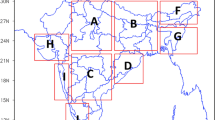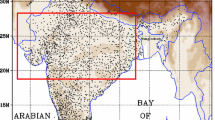Abstract
Weather forecasts by any forecast system are verified using either distributions-oriented or measures-oriented forecast verification measures. Both the forecast verification schemes represent different aspects of the forecast quality, and advantages of them can be utilized to get better insight and to identify particular strengths (deficiencies) in the forecast performance of any forecast system. Keeping this in view, multi-faced verification (binary and continuous) of quantitative precipitation forecasts for consecutive 3 days by a Regional Meso-scale Weather Simulation Model (MM5 Model) has been carried out to get complete insight into its performance. The MM5 model forecasts at 10-km resolution for 792 days of six winters (winter 2003/2004 to winter 2008/2009) are compared with the observational data of six stations in the complex topography of Northwest Himalaya (NWH) in India. The model forecasts are verified using binary categorical forecast verification measures such as Probability of Detection, False Alarm Rate, Miss Rate, Correct Non-occurrence, Critical Success Index and Percent correct, and continuous forecast verification measures such as Mean Absolute Error (MAE) and Root Mean Square Error (RMSE). BIAS is computed to know over-forecast/under-forecast tendency of a precipitation day (PT day) by the MM5 model. MAE (RMSE) of the MM5 model is computed separately for all days, PT days and no precipitation days (NPT days). MAE (RMSE) of PT days is found to be relatively larger as compared to NPT days and all days. These findings indicate that MAE (RMSE) computed separately for all days, PT days and NPT days provides better insight into the performance of the MM5 model. Results also suggest that the MM5 model shows reasonably good performance for binary forecasts (PT days/NPT days) for day 1 (0–24 h), day 2 (24–48 h) and day 3 (48–72 h). However, large errors are seen in predicting the observed precipitation amount of PT days over NWH.








Similar content being viewed by others
References
Ashley WS, Andrew JK, Schwantes R (2008) Vulnerability due to nocturnal tornadoes. Weather Forecast 23:795–807
Barros AP, Chiao S, Lang TJ, Burbank D, Putkonen J (2006) From weather to climate—Seasonal and interannual variability of storms and implications for erosion processes in the Himalaya. Tectonics, Climate, and Landscape Evolution: Geological Society of America Special Paper, pp 17–38, doi: 10.1130/2006.2398(02)
Bertness J (1980) Rain-related impacts on selected transportation activities and Utility services in the Chicago Area. J Appl Meteorol 19:545–556
Bhutiyani MR, Kale VS, Pawar NJ (2007) Long-term trends in maximum, minimum and mean annual air temperatures across the Northwestern Himalaya during the twentieth century. Clim Chang 85:159–177
Brooks HE, Doswell CA (1996) A comparison of measures-oriented and distributions-oriented approaches to forecast verification. Weather Forecast 11:288–303
Colle BA, Mass CF, Westrick KJ (2000) MM5 precipitation verification over the Pacific Northwest during the 1997–99 cool seasons. Weather Forecast 15:730–744
Dai A (2006) Precipitation characteristics in eighteen coupled climate models. J Clim 19:4605–4630
Das S (2003) Mesoscale modeling for mountain weather forecasting over the Himalayas. Bull Am Meteorol Soc 84:1237–1244
Das S (2005) Mountain weather forecasting using MM5 modeling system. Curr Sci 88:899–905
Das S, Ashrit R, Moncrieff MW (2006) Simulation of a Himalayan cloudburst event. J Earth Syst Sci 115:299–313
Das S, Ashrit R, Iyengar GR, Mohandas S, Gupta MD, George JP, Rajagopal EN, Dutta SK (2008) Skills of different mesoscale models over Indian region during monsoon season: forecast errors. J Earth Syst Sci 117:603–620
Davis C, Brown B, Bullock R (2006) Object based verification of precipitation forecast. Part II application to convective rain systems. Mon Weather Rev 134:1785–1795
Dudhia J (1993) A nonhydrostatic version of the Penn State-NCAR mesoscale model: validation tests and simulation of an Atlantic cyclone and cold front. Mon Weather Rev 121:1493–1513
Ebert EE, Wilson LJ, Brown BG, Nurmi P, Brooks HE, Bally J, Jaeneke M (2004) Verification of nowcasts from the WWRP Sydney 2000 forecast demonstration project. Weather Forecast 19:73–96
Furman RW (1982) The effectiveness of weather forecasts in decision making: an example. J Appl Meteorol 12:532–536
Grell GA, Dudhia J, Staffer DR (1994) A description of fifth generation Penn State/NCAR mesoscale model (MM5), NCAR Technical Note, NCAR/TN-397 + IA
Hong SY, Pan HL (1996) Nonlocal boundary layer vertical diffusion in a medium-range forecast model. Mon Weather Rev 124:2322–2339
Johnson LE, Oslen BG (1998) Assessment of quantitative precipitation forecasts. Weather Forecast 13:75–83
Jolliffe IT, Stephenson DB (2003) Forecast verification: a practitioner’s guide in atmospheric science, 4–5. Wiley, Chichester
Keenan T, Joe P, Wilson J, Collier C, Golding B, Burgess D, May P, Pierce C, Bally J, Crook A, Sills D, Berry L, Bell I, Fox N, Pielke R Jr, Ebert EE, Eilts M, O’Loughlin K, Webb R, Carbone R, Browning K, Roberts R, Mueller C (2002) The sydney 2000 world weather research programme forecast demonstration project: overview and current status. Bull Am Meteorol Soc 84:1041–1054
Kumar TSV, Vijaya Krishnamurti TN (2006) High resolution numerical weather prediction over the Indian subcontinent. J Earth Sys Sci 115:529–555
Lang TJ, Barros AP (2004) Winter storms in the Central Himalayas. J Meteorol Soc of Japan 82:829–844
Mandal V, De UK (2007) Precipitation forecast verification of the Indian Summer Monsoon with intercomparison of three diverse regions. Weather Forecast 22:428–443
Mason SJ (2008) Understanding forecast verification statistics. Meteorol Appl 15:31–40
Murphy AH (1991) Forecast verification: its complexity and dimensionality. Mon Weather Rev 119:1590–1601
Murphy AH (1997) Forecast verification. In: Katz RW, Murphy AH (eds) The economic value of weather and climate forecasts. Cambridge University Press, Cambridge, pp 19–74
Murphy AH, Winkler RL (1987) A general framework for forecast verification. Mon Weather Rev 115:1330–1338
Murphy AH, Brown BG, Chen Y (1989) Diagnostic verification of temperature forecasts. Weather Forecast 4:485–501
Olson DA, Junker NW, Korty B (1995) Evaluation of 33 years of quantitative precipitation forecasting at the NMC. Weather Forecast 10:498–511
Pielke R JR, Carbone RE (2002) Weather impacts, forecasts and policy. Bull Am Meteorol Soc 83:393–403
Regnier E, Harr PA (2006) A dynamic decision model applied to Hurricane Landfall. Weather Forecast 21:764–780
Singh D, Dimri AP, Ganju A (2008a) An analogue method for simultaneous prediction of surface weather parameters at a specific location in the Western Himalaya in India. Meteorol Appl 15:491–496
Singh D, Singh A, Ganju A (2008b) Site specific analog weather forecast system for northwest Himalaya, India. Ann Glaciol 49:224–230
Srinivasan K, Kumar A, Verma J, Ganju A (2010) Statistical downscaling of MM5 model output to better assess avalanche threats. Ann Glaciol 51:14–18
Wilks DS (1995) Statistical methods in the atmospheric sciences. Academic, San Diego, pp 233–283
Woodcock F (1976) The evaluation of yes/no forecasts for Scientific and Administrative purposes. Mon Weather Rev 104:1209–1214
Zhang H, Casey T (2000) Verification of categorical probability forecasts. Weather Forecast 15:80–89
Acknowledgments
The authors are very thankful to Sh Ashwagosha Ganju, Director, SASE for his constant encouragement during this study. Positive criticism of the work and invaluable suggestions for improving the quality of the manuscript by anonymous reviewers is highly acknowledged. The study would not have been possible without efforts of Scientists and Technical Assistants of SASE, who collected data under harsh climatic conditions of NWH.
Author information
Authors and Affiliations
Corresponding author
Additional information
Responsible editor: B. Ahrens.
Rights and permissions
About this article
Cite this article
Singh, D., Bhutiyani, M.R. & Ram, T. Station-based verification of qualitative and quantitative MM5 precipitation forecasts over Northwest Himalaya (NWH). Meteorol Atmos Phys 125, 107–118 (2014). https://doi.org/10.1007/s00703-014-0321-9
Received:
Accepted:
Published:
Issue Date:
DOI: https://doi.org/10.1007/s00703-014-0321-9




